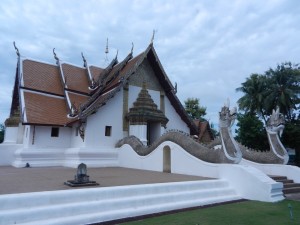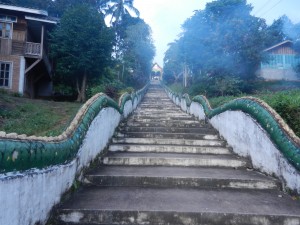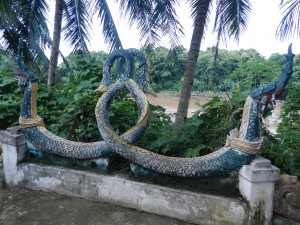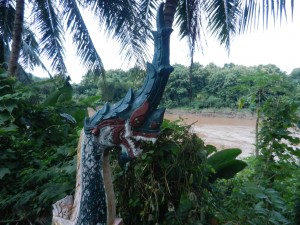The section of Hampton Court Palace that England’s king William III (1689-1702) built looks like the Western tradition’s most common model of truth and order.
Geometrically proportioned, permanent and beautiful–just like the laws of physics Isaac Newton was discovering around the same time. And like the measured verses the poet John Dryden was crafting. England after the monarchy’s restoration in 1660 was reaffirming the West’s assumptions about the basis of reality. So what’s up with these snakes?
The serpents slithering from Wat Phumin in Nan, Thailand express another culture’s way of ordering the world. Judging from the number of beer-sloshing British tourists I saw in Chiang Mai, Thai perspectives have all the wealth of Buckingham Palace.
The serpents at Wat Phumin (founded in 1596) seem to be slithering through the assembly hall–their tails jut out the other end. So their undulating bodies are a very basic architectural form.
It’s thus no surprise that you find them in many places in a wat.
They guard the temple’s entrance–including this wat’s in the mountains near Luang Prabang, Laos.
Their long bodies undulate down the stairway to Wat Chomkao Manilat in Huay Xai, Laos. They project both grace and power.
The last post examined the prominence of serpents on roofs of wats’ assembly halls. So why treat them as foundational?
Nature gives much of the answer.
The interlocking bodies of the 2 nagas (serpents) in this small wat near Luang Prabang, Laos resemble the dense intertwining foliage that surrounds them.
People in cultures all over the world have been fascinated by snakes. They seem to embody nature’s energies. But Southeast’s undulating rivers and intertwining jungles have given them heightened meaning. You can’t separate snakes from the forces that created the world. The ancient Hebrews imagined god Yahweh as towering over all of nature, and punishing the serpent who tempted Eve with the apple by ordering it to live a degraded existence by slithering like the lowest beasts. But nature is too abundant and intertwined for most Southeast Asians to be into absolutes. The environment harbors a multitude of souls, and all have to get along.
Myths about some of the wats in Luang Prabang tell of appeasing the local naga before building the temple. Stories of Buddhist temples and nagas living in harmony are more popular than the Christian legend of St. George slaying the dragon. Joint ventures were worked out instead. Nagas guard wats, and the Buddha gives them blessings.
People in Southeast Asia have learned to coexist with all souls in their environment for thousands of years. Peaceful living with a multitude of life-forms has been the most common idea of truth in Southeast Asia.
I wandered through a lot of little villages in the mountains of Laos, and the people were always welcoming and gentle. I found them as dignified as Hampton Court.








Comments on this entry are closed.